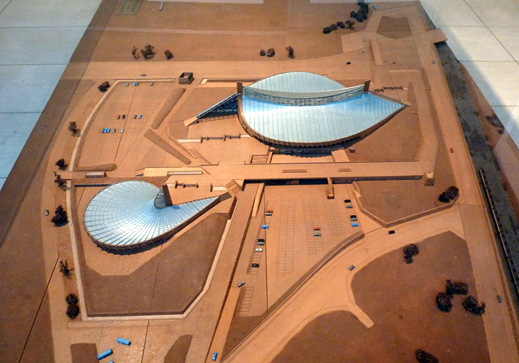 |
| Original model of the National Gymnasiums for the Tokyo Olympics (1964) by Kenzo Tange. |
|
|
In conjunction with the release of GA Japan magazine's 100th issue is an exhibition entitled "Contemporary Japanese Architecture Seen from Abroad" at the GA Gallery in Sendagaya, Tokyo. GA is the ubiquitous Japanese publisher of hefty magazines, quarterlies and retrospective volumes on architecture and interior design. It is no surprise that the GA exhibit itself feels like walking inside one of their coffee-table books. The gallery features a double volume space and a second floor video viewing room in exposed concrete. Daylight enters through storefront windows that are buffered by the GA Gallery bookstore. It has a calm, unsupervised atmosphere that encourages lingering. On display are models, sketches, photographs and filmed interviews that introduce work by 18 contemporary Japanese architects, some living, some not. There is very little text accompanying the works and that is entirely in Japanese.
It was not clear how these 18 individuals were selected. Are they the most popular, the most influential? Do they have the most international acclaim? Among those featured are certainly some well-known names in architecture, including Kenzo Tange, Toyo Ito, and Tadao Ando. Because the panels are arranged chronologically by birth year around the walls of the gallery, three other greats, Fumihiko Maki, Kisho Kurokawa and Arata Isozaki, wound up relegated to a back corner of the space while less prolific architects (Kazuyo Seijima and Riken Yamamoto) enjoy prominent positions in the front. Admittedly, trying to narrow down Japan's most important architects to just 18 individuals is not an enviable task. A number of international favorites such as Minoru Yamasaki, Shigeru Ban and Yoshiyo Taniguchi did not make the short list, yet surely they have earned top seats in Japan's "Architecture Hall of Fame."
If this exhibition is meant to be a popularity contest, Kenzo Tange comes out the clear winner. Four large central photos are displayed of the Kagawa Prefectural Government Office (1958), the Hiroshima Peace Memorial Museum (1952), the Master Plan for Expo '70 Osaka (1970), and of course the National Gymnasiums for the Tokyo Olympics (1964) accompanied by the original model. Tange rightfully deserves the recognition he receives at home and abroad.
Captivating early works are on display by two architects now known for their heroic gestures. The first is Hiroshi Hara's private home and atelier (completed in 1974). This is a modest-scaled but highly detailed execution of early postmodernism. On display is a delicate model divided into three parts, a hand-rendered axonometric, and photos of Hara and his young staff circa 1970. Today Hara is best known for the massive Kyoto JR Railway Station (1997). The second is Tadao Ando's Azuma House, also called the Sumiyoshi Nagaya, built in Osaka in 1976. This sublime townhouse (measuring only 3.2 meters wide and about 12 meters long) is situated on what seems an impossibly narrow site. The rooms are stacked at either end and joined by an open-air bridge through a central courtyard. The Azuma House is a classic precedent in small urban housing for students of architecture worldwide.
"Contemporary Japanese Architecture Seen from Abroad" was a great opportunity to explore why the rest of the world has been fascinated with Japan's built environment for over a century. The question "How has Japan's high standard of inventiveness, craft and execution inspired you?" might have been posed to foreign architects as part of the interview sequence. Unfortunately the exhibit did not take this exploration far enough, instead self-consciously side-stepping any international perspective. Despite catering to a strictly domestic audience, the GA Gallery exhibition can be seen as a formidable primer on contemporary Japanese architecture.
|
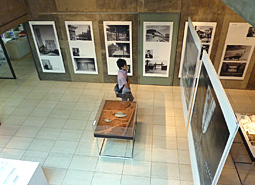 |
|
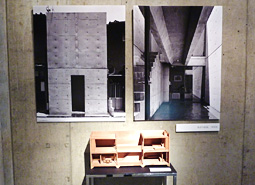 |
| A view of the GA Gallery's exhibition space from the mezzanine level. |
|
A section model of Tadao Ando's Azuma House (Osaka, 1976), which measures just 3.2 meters wide. |
|
|
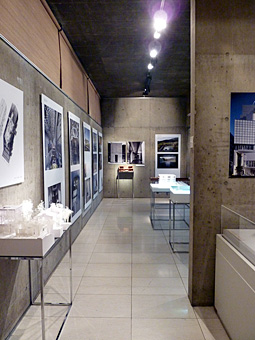 |
|
 |
| Works on display in the exhibition "Contemporary Japanese Architecture Seen From Abroad." |
|
Hiroshi Hara's home office, divided into three parts for easy viewing. |
|
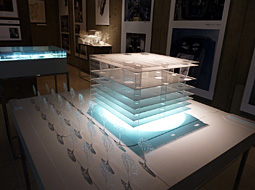 |
|
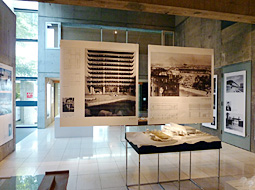 |
| A simple, glowing model of the Mediatheque building (Sendai, 2001) by Toyo Ito. |
|
Two large central panels feature images of Kenzo Tangefs work front and back. Shown are the Kagawa Prefectural Government Office, 1958 (left) and the Hiroshima Peace Memorial Museum, 1952 (right).
|
|
|
|